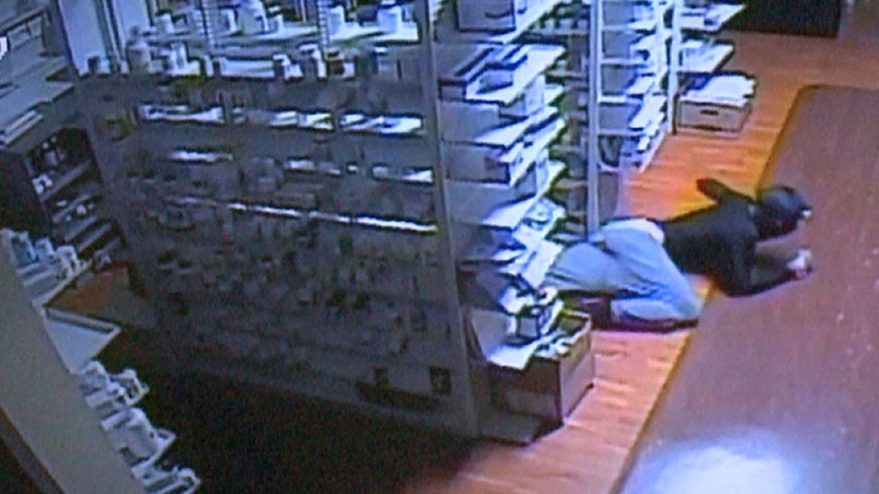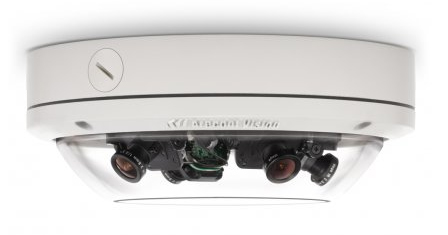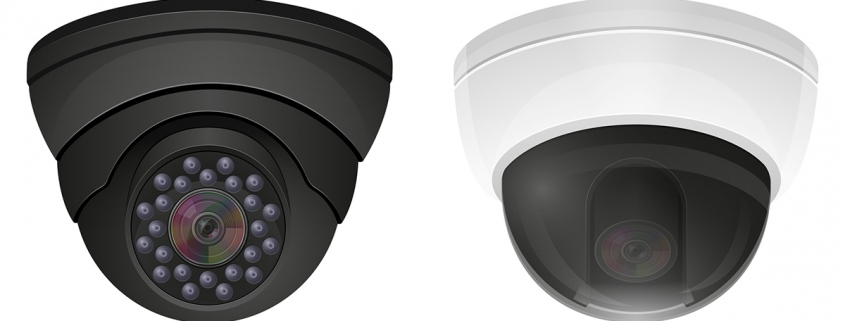Most companies that are successful in business are at risk for some loss. Whether it’s proprietary information, company property, employee/customer relations or loss of retail merchandise, businesses should be concerned about protecting themselves. Listed below are some of the more popular reasons a business should consider the installation of a video surveillance system.
- To Prevent Vandalism
- To Reduce Thefts/Break-ins
- To Deploy Cost Savings Measures
- To Increase in Employee Productivity
- For Video Documentation
- To Enhance the Customer Experience
- To Grant Customer and Employee Access
- For General Peace of Mind
When designing a business video surveillance system, the components selected should be based upon the reason the system is being deployed, with giving consideration to how the system will be wired and not just based upon the price alone. This investment should fit the purpose and be designed accordingly. Below is a list of topics to be discussed with some personal insight. The list is not all-inclusive but is a good start for a discussion on your system’s design. While the terminology can be confusing, the simplest rule we can provide is most integrators will do demonstrations. Furthermore, you should minimally look at camera views at some of their other installations, view the software or web portal you will be using to view/playback, check their references and get pricing on support and maintenance, you will need it.
Types of Connectivity (Analog vs. IP/Digital)
Analog systems have been around since the middle of the 20th century. They were prevalent and became mainstream in the 1970s. The analog cameras required two separate cables, one for the transmission of the video or data signal and one for camera power. The wiring was installed in a “home run” fashion meaning each camera installed had to have its own wiring from the camera to the recording unit. If you were to draw a wiring diagram the recording unit would be in the center of the drawings and all the cameras would be drawn as nodes independently attached to the recorder.
An IP (Internet Protocol) or digital based system, which became more popular in the late 1980s utilized a different type of wiring, Category 5 wiring or twisted pair wiring and connected a recording unit to a digital camera. The digital cameras allowed for a higher resolution of the images being recorded. The wires didn’t need to be “home run” just connected utilizing a switch (or hub) so that all the wires were eventually connected in a network fashion back to the recording unit.
Digital Camera Technology
The most apparent advantages of this type of system were the ease of the installation. The cameras could be connected using one wire which would deliver power and data and the images were much clearer. The older analog images appeared grainy and when enlarged would get more grainy or pixilated. The digital images provided a sharper image and when enlarged, would provide a crisp image. As technology improved the digital cameras evolved from 1 megapixel to 20 megapixels (or even higher) and the quality of those images were dramatically enhanced as well. The megapixel quality continues to improve allowing cameras to focus on an image, record those images on large storage arrays and then enhance the playback for a crisp, “zoomed-in” close-up of a section of that image, which would have been impossible with an analog system.
DVRs vs VCRs
The older systems recorded images on a VCR (Video Cassette Recorder) and those units required the replacement of a video cassette tape on a daily basis. Playback was very cumbersome as you had to rewind tapes and fast forward to those portions of the video you wanted to review. The analog systems evolved in the late 80s and early 90s when hard drives became more affordable and the recording unit changed to a DVR (Digital Video Recorder).

As the local area network became popular for businesses, the NVR was born. The Network Video Recorder allowed IP cameras to be connected to a network utilizing special POE (Power over Ethernet) switches and be recorded on a server designed to accommodate 24/7 operation with large storage capabilities. The hard drives used for video surveillance are different than those used for regular storage. These devices are designed to be reading and writing 24/7.
Network Video Recorders vs. Digital Video Recorders vs. Hybrids
The biggest differences between network video recorders and digital video recorders are;
- The price tag
- The amount of cameras that can be connected to a single recorder
- The method in which the video transmission is recorded
- Where the NVR/DVR has to be located
A DVR will be limited to a specific number of channels (or cameras) were an NVR will require licenses and allow many more cameras to be connected, thus the reason an NVR will usually cost more. As an example, a DVR might have 8 channels and a 2 terabyte hard drive and you would not be able to connect any more than 8 cameras. A comparable NVR might come with 8 channels and 2 terabytes but will allow you to expand and connect another 8, 16 or even more cameras as well as allow you to add additional hard drive storage. NVRs have many storage options as well, like the ability to add a RAID (redundant array of independent disks) storage array in case a hard drive fails, your recordings would still be preserved. An NVR is, in fact, a server and not a stand-alone recording box. The NVR would require more software support and maintenance and would need to stay current with the network. Both DVR and NVRs can connect to analog and digital cameras if the recorder is a “hybrid” which incorporates analog and IP connections on the back of the same recorder. Lastly, the NVR can go almost anywhere on the network, where a DVR must be located so that each camera can connect directly to it.
What to Look for in an NVR or DVR
DVRs work fine for small single site installations. In situations where there is no expansion required, no need to keep video for more than a couple weeks, only 1 or 2 remote users accessing the footage from their iPhone and price is a major concern, and a DVR might be the right fit.
NVRs are a different animal. They are designed for expansion, multiple remote users, months of storage at very high picture quality and designed for a specific purpose. When deploying an NVR they can be designed to handle analytics which allows the video to be “analyzed” as its being stored. This means you would be able to set rules or flags when there is a specific occurrence of the video. For example, if there is a group of individuals standing by a fence for more than 30 seconds, video analytics would be able to alert you. This can be very helpful if you have many, say hundreds of cameras to watch and need the assistance of software to help you analyze any issues that may occur that need to be acted upon instantly. Casinos, airports, water treatment facilities, shipping yards and enterprise businesses are just a few of the many facilities where an NVR with analytics would be the right choice.
Frame Rates
There are also limitations on frame rates on DVRs that an NVR may not be subject to. Typically NVRs can capture higher frame rates on more cameras simultaneously than a DVR can. This allows for a higher quality playback when you review the footage. If it’s important to see every action or you are looking at items that travel very quickly, then you’ll need a higher frame rate. Vehicles moving should be recorded at high frame rates at least 24 frames per second or more. Most NVRs offer 30 frames per second per camera standard. Remember when you lower the frame rate to 10 or below the images you view will start to get a little choppy.
Motion Recording
Most DVRs/NVRs will allow you to program a camera to only record video when there is movement (or motion). Motion recording will save you hard drive space. This option allows you to record a few seconds before and a set amount after the scene detects movement. If you want to see the entire scene, motion recording may not be the best answer as it may not record the entire scene.
 Compression Types
Compression Types
DVRs and NVRs have various options when it comes to recording compressions. At the time of this blog, H.264 had been the standard in video compression. If you are purchasing a DVR or NVR and it’s not recording at H.264 compression than you should reconsider the purchase. With the advancement in digital imaging with 4k and 8k cameras, the latest compression is H.265. The best compression technology will cost a little bit more, but it will also allow you to stream your video faster because it requires smaller bandwidth. H.265 (or HEVC) will also require less space to store the same video, therefore, conserve storage space.
Health Monitoring
Some DVRs and NVRs offer health monitoring which should be considered as an option. If you are concerned that the video will be there when you need it, then make sure to select this option. This can easily be handled if the unit deploys health monitoring. The health rules vary from manufacturer, but should minimally include, temperature alerts, loss of video from a camera, power outages, not recording, hard drive errors or possible malfunction and offer email alerts or the ability to have it supervised offsite by a third party monitoring company. There is usually an additional subscription cost to have this deployed correctly.
Concurrent Connections
Most clients like to be able to watch their cameras remotely. DVRs will limit the number of concurrent connections based upon the DVR. Typically the more cameras you have connected to the DVR will somewhat affect the number of connections. If you are concerned with how many people can access the live streams, consider installing an NVR which will allow many more connections. I have seen some DVRs that allow two concurrent connections while an NVR with the same number of cameras will allow 25 or more concurrent connections.
Camera Types and Terminology
When it comes to selecting the right cameras, you should speak with an expert. Various features should be considered based upon the purpose and the location of each camera you install. Cameras come in many different shapes and have different features which will ultimately determine the price you pay.
Indoor/Outdoor
Cameras are rated for indoor or outdoor use. If there is no exterior rating, then assume the camera is rated for indoor use only (away from moisture, dust and the elements). Ratings such as IP65/IP66 and IP67 will tell you where outside cameras can be installed. The first number in the rating refers to the level of protection against foreign objects such as dirt and dust with 6 being the highest level of protection (“6” completely dust tight). The second number refers to moisture with 8/9 being the highest (referring to immersion) which very few cameras will have this rating unless they are designed to be installed underwater. Most exterior cameras I have seen are rated IP66 or IP65.
WDR (Wide Dynamic Range)
Anyone installing a camera in the front of their store looking out towards daylight knows that as soon as the door opens, a burst of natural sunlight also comes in. This event will play havoc with the camera’s iris by washing out the subject. In this situation, a camera with WDR should be used, and this would enable objects in both bright and dark areas to be visible in the recordings.

The new Arecont Vision compact MicroBullet Indoor/Outdoor Day/Night Megapixel WDR Camera
Varifocal vs Fixed Lens
Fixed focal lenses are the least expensive lens and come in preset focal points. The lens on the camera determines how wide and far the image will be viewed on the screen. For example, if you are placing a camera in the corner of a stairwell and it’s a very tight space but you would like to have a very wide field of view, you would need a lens with a 2.8mm setting. If you purchased cameras with a fixed focal lens of 6mm you would not get the best shot of the stairwell. Most varifocal lenses come with a 2.8 to 12mm setting. A varifocal lens will allow you to install the camera then adjust the viewing image so you see exactly what you want to see. A varifocal lens is a smart decision unless you know exactly what you want to see and have a lens calculator to determine the proper lens for each camera.
Motorized vs Manual Focus
With any camera, if it’s not focused, you’ll have a blurry image regardless of the quality of the camera. Once properly installed, the cameras are focused on a specific field of view. Over time, a camera may lose focus from the effects of Mother Nature, due to extreme temperatures and vibration of wind. Cameras with a motorized focus allow the operator to adjust the focus through the software of the camera. Motorized zoom lenses could offer significant savings over the life of the camera. Imagine what’s involved having to adjust a camera’s focus if the camera is on a bridge or on the second floor of your building.
Dome/Bullet/Eyeball
Cameras come in many different shapes and sizes again designed for a specific purpose. Depending upon the type of installation, you will determine the type of housing for your camera. A dome or eyeball camera is usually a self-contained device. The bullet camera is shaped like a long cylinder and can be self-contained or can be assembled in the field by using a box camera with a specific lens and placed in a protective housing. They make Dome cameras in many different options. Some manufacturers make a dome camera which when installed using a “tear-drop” bracket, can see 360 degrees. Dome cameras should be mounted so not to be affected by the bright sunlight or excessive rain or snow. It’s best to install these cameras using a bracket designed for the specific camera.
IR/Day/Night
Depending upon the amount of natural light you have during the day and at night, you should consider a camera designed for that purpose. It’s best to install cameras with 0 lux, low light or with IR when you are concerned about having very little or no lighting when you are trying to capture video. IR or Infrared cameras have the ability to capture video in low light. These are also referred to as “Night Vision” cameras. IR cameras also have a field of view rating for the IR emitters. In some cases, its 30 to 90 feet depending upon the number of IR emitters built into the camera. If the camera IR rating doesn’t cover the field of view you can always install stand-alone IR blasters which can go hundreds of feet for an additional cost. Some low lux cameras are designed to use a very little light to enhance the image.
Wired/Wireless
All cameras require some sort of power. Arlo recently released a complete wireless camera with a rechargeable battery that works on wifi. Most professional grade surveillance systems use wired cameras. It is possible to also transmit a wired video signal from one building to another with the use of powered beam technology. In essence, you are beaming the video signal from one building to the next and eventually to the network video recorded. Wireless cameras do have their place. They are relatively inexpensive and can be easily installed without mounting them permanently, they can be placed on a table, plugged into an outlet and then connected to your wifi and once enabled through an app, you’ll have the ability to view your home remotely. They are limited in image quality and bandwidth and will most likely not store months of video unless you purchase a separate storage plan.
Audio
Some cameras have the capability of audio. Would you like to stop someone from climbing in your fenced in yard? Or how about speaking to the delivery boy at your front door while you are not home? With advancement in technology you are now able to listen and or speak through the camera (not exactly), but through the device, if it’s enabled with audio.

Cloud Based Recording Options
In some installations, it’s important to preserve the video in case of a break-in. It’s very easy to locate a DVR if you know where to look. Furthermore, trying to playback a recording won’t work if your DVR has been stolen! Cloud-based recording or recording on a MicroSD card inside the camera are good options to help protect from video loss by theft, corruption of the hard drives in the DVR or NVR. A MicroSD card helps in case the camera loses its connection to the recorder as well, but still has power.
Viewing Options
It’s important to review how the app or software works to view the cameras while on and off site. Do you want certain cameras to be seen in a specific arrangement on your mobile device? How easy is it to search for footage and playback while off site and how long does it take to play? If you have concerns about watching live and recorded video offsite from a mobile device or computer, you should demo the software and review its functionality before making a decision. This will be very important since most likely you will be using your remote access much more than accessing the video while on site. Some systems allow for custom views which allow you to redesign the boxes on your portable device in any manner you choose. If you have multiple locations and would like to have all the cameras from the registers appear on one screen from multiple sites, make sure to request this option, it’s not available on every platform.
Analytics and Monitoring
Video verification is becoming more prevalent. Allowing a security system to send a signal to the central station when it detects an intrusion along with a video clip of what happened; say 15 seconds before the alarm and 15 seconds after the alarm can really help the monitoring station determine what the cause of the alarm was. This will reduce false alarms and allow the authorities to work more efficiently. Some video surveillance systems have the ability to be monitored through a central station designed for watching the video which is different than the central stations designed to monitor security systems. By using video analytics or a trip from a security system, the video guard station can actually watch what is happening in real-time, and speak to the individuals on site, almost like having a guard on site. Depending upon the situation the video guards can dispatch police or try and deter the person from committing a crime knowing they are being watched and spoken to usually gets them to leave very quickly.
In conclusion, it’s very important to determine the reasons for installing video surveillance and utilize an experienced integrator to help in the design. If you just attempt to get three quotes for a video surveillance system, you’re rolling the dice. Most systems can be custom designed regardless of whether you need two cameras at one site or if you plan to integrate one platform with hundreds of cameras at various sights, there’s a solution for almost every installation.







